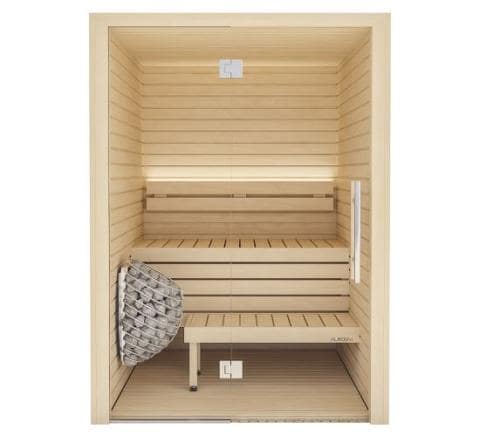How Traditional Sauna can Save You Time, Stress, and Money.
Wiki Article
The smart Trick of Traditional Sauna That Nobody is Talking About
Table of ContentsThe 10-Minute Rule for Traditional SaunaTop Guidelines Of Traditional SaunaTraditional Sauna Can Be Fun For AnyoneTop Guidelines Of Traditional Sauna
A lot of the weight shed in a sauna is water loss and is re-gained upon rehydrating. Without an uncertainty sauna can be a crucial part of a healthy and balanced weight loss program. To consider the differences in between standard and IR saunas, I will certainly divide these right into verifiable, academic, and made differences.Hence, the most popular factor in the saunawhich goes to the ceiling directly above the sauna heateris normally in between 185 and 190 F. Traditional Sauna. Claims that a traditional sauna exceeds 200 F is merely not real and not appropriate for electrical saunas marketed in the United States. The temperature level for a far-infrared sauna is usually set in between 120 and 140 F; nevertheless, unlike the conventional sauna, the objective in and IR space is not to achieve a heat
As a result of this, the temperature level difference is nearly irrelevant, because extreme sweating results in both sauna kinds, however the technique of heating up the body is various. In an IR sauna the bather will certainly really feel hot and will certainly sweat a lot, however at much reduced temperatures. Therefore, if the objective is to spend longer time periods in the sauna, the IR sauna is a great choice.

The Main Principles Of Traditional Sauna
When the high temperature level is achieved, the aspects cycle on and off to preserve the heat. A lot of typical sauna customers appreciate pouring water over the rocks to develop heavy steam to raise sauna moisture degrees. The advantages of putting water over the rocks consist of: making the room extra comfortable, moistening the nasal flows, and enabling the usage of aromatherapy by mixing necessary oils with the water.In a far-infrared sauna, the warmth waves penetrate the body to properly heat up the body and elevate the body core temperature. To achieve this enhanced temperature level, Far-infrared emitters develop infrared energy which is close to the same wavelength have a peek at these guys as that which the body naturally emitsoften described as the "Crucial Variety" of 7 to 14 microns), so the power is well gotten by the body.
When the energy gets in the body, it causes the body temperature to enhance and ultimately leads to sweating. In an infrared sauna it's crucial for the emitters/heaters to continue to be on practically regularly. Given that there is no mass of rocks to maintain heat, the sauna will cool if the emitters shut off.
As discussed above, the sauna bather in an infrared room look at these guys intends to position himself before running emitters to obtain optimal gain from the warm. The home heating time for the 2 areas can be extremely various, relying on just how the spaces are made use of. For a conventional sauna, a bather ought to allow 30-40 mins for the area to accomplish a desired temperature level and to properly pre-heat the rocks.
Traditional Sauna - Questions
A well built sauna will usually achieve a temperature of 150-160 F in regarding 30-40 mins. For hotter temperature levels, the room might need to warm for a longer duration.To some, 15 minutes was "lost" while the infrared energy heated the wood panels instead than heating a body, while others find a pre-heated area to be more comfortable and think a raised starting temperature level is required to start sweating. The length of suggested usage for each space is about the same (10-15 minutes per session); however, as a result of the lower air temperature levels and the capability to really feel the effects of infrared heat quicker than a conventional sauna, it is not unusual for a person to invest a total amount of 20-30 minutes in an infrared sauna.
Standard saunas often tend to be bigger (thus use even more electricity) than infrared saunas, although conventional saunas are certainly readily available in one and 2 individual sizes too. For a two-person traditional sauna, 5x6 or 5x7 size is most prominent. The leading bench can comfortably visit their website seat two or 3 individuals and is also long sufficient to relax during the sauna session.


The average expense per kWH of electrical power in the united state is about $0.11, so a 4.5 kW heating system will certainly set you back about $.50 to compete one hour, if the heater runs constantly for one hour. Normally a sauna heating system will certainly compete 75% of the initial hour and 50% of subsequent hours on because the components cycle once the set temperature level is achieved.
Getting The Traditional Sauna To Work
A 2 person far-infrared area is normally literally smaller than a traditional sauna, usually regarding 4' x 4' or smaller. The IR home heating system is generally 1.5-1.7 kW utilizing a 120 volt 15 amp plug-in service. Because the room can be used earlier than a sauna room, we will think the space is utilized for to of an hour including warmth up time.Finally, there is a rarely reviewed distinction in the social experience in between both spaces. While our culture has actually lost several of the social advantage of the traditional sauna experience, it can be extremely socially fulfilling. From household time in the sauna, to heart-felt conversations with loved ones, to sauna partiesthe traditional sauna experience can bring about intimate socializing.
Most higher end infrared spaces consist of tinted light treatment, sound systems and full-glass fronts.
Report this wiki page